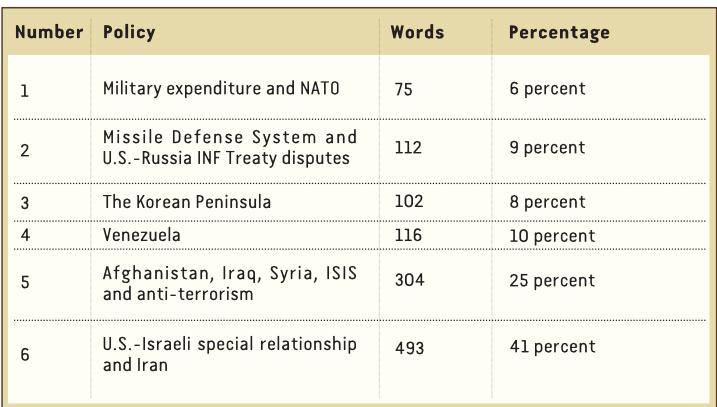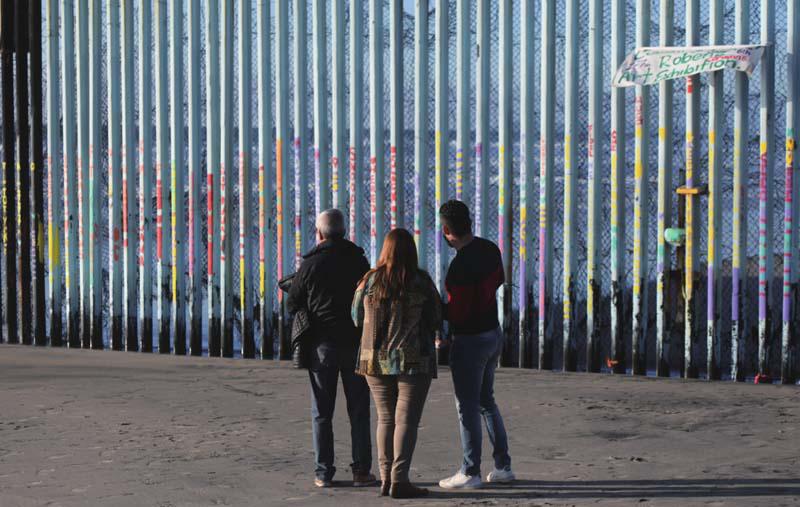Trump’s Foreign Agenda
2019-03-05ByWangPeng
By Wang Peng


U.S. President Donald Trumps second State of the Union address took place on February 5. As U.S. media noted, this speech was delayed by two weeks amid the longest government shutdown in U.S. history and took place as the president and U.S. Congress were trying to fi nd a solution to avert another shutdown.
In the speech, Trump stated, “Together we can break decades of political stalemate. We can bridge old divisions, heal old wounds, build new coalitions, forge new solutions, and unlock the extraordinary promise of Americas future. The decision is ours to make.”
The real effectiveness of breaking“political stalemate” and bridging “old divisions” still remains to be seen.
Structure of the speech
The speech has roughly four parts. The beginning reviews the history of the U.S. to arouse the pride and glory of Americans.
The second part reviews the achievements of the Trump administration during the past two years with unreserved selfpraise; the third details eight major policies that Trump has implemented and accounts for nearly 70 percent of the speech.
The final part summarizes the speech and calls on Americans to follow him to“rekindle the bonds of love and loyalty and memory that link us together as citizens, as neighbors, as patriots,” “keep freedom alive in our souls,” “keep faith in Americas destiny,” and “choose greatness.”
It can be seen clearly that domestic affairs (due to the America First principle) are of paramount importance. Trumps speech carries the slogan “We must be united at home to defeat our adversaries abroad.” Domestic policies include criminal justice reform, illegal immigration, womens rights, trade, infrastructure rebuilding, medical care re-reform and, of course, the wall along the U.S.-Mexico border.
Trump spoke about national security and foreign policy for about 33 percent of the speech.
Key points on foreign policy
As the table below demonstrates, there are six major facets in Trumps policy regarding national security and foreign affairs. The focus is clear since the discourse about the Middle East (No. 5 and 6) accounts for 66 percent of Trumps foreign policy statement, while all other affairs share the remaining 34 percent.
● Military expenditure and NATO
Trump defends and legitimizes his decision to “fully rebuild the United States Military”—with $700 billion in 2017 and$716 billion in 2018. And he also urges NATO allies to share a larger portion of the military expenditure.
● Missile defense system and U.S.- Russia INF Treaty disputes
As part of the U.S. military build-up, Trump is developing a state-of-the-art missile defense system. With regard to the Intermediate-Range Nuclear Forces Treaty(INF) between the U.S. and Russia, Trump holds a hardball attitude, threatening to offi cially withdraw from the treaty.
● The Korean Peninsula
Trump appeared to be very proud of his “historic push for peace on the Korean Peninsula” and championed his efforts to prevent “a major war with North Korea with potentially millions of people killed.” He revealed the time and place of the second Trump-Kim Jong Un Summit with apparent confidence. It will be on February 27 and 28 in Viet Nam.
● Venezuela
Trump recognized regime change in Venezuela and said the United States will “stand with the Venezuelan people in their noble quest for freedom.” He used Venezuela as a typical case to push American values, such as anti-socialism.
● Middle East I: Afghanistan, Iraq, Syria, ISIS and anti-terrorism
Middle East affairs occupy an important place in the Trump administrations current foreign policy. This is the paramount section in the international and regional affairs segment, second only to “illegal immigration.”
● Middle East II: Israel and Iran
Trumps Middle East policy unreservedly supports the special U.S.-Israeli relationship and underlines the “sin”and “threat” of Tehran through the perspective of “principled realism.” Trump turns to the issue of the war against ter- rorism, and then “naturally” repeats his accusation that the Iranian Government is “a regime that chants death to America and threatens genocide against the Jewish people.”
In conclusion, we can deduce that Trump intended to show his “extraordinary”and explicit pro-Israel policy preference, as well as his open and relentless hatred of Iran.
All the “love” he has shown to Israel and the recall of the shared memory between the U.S. and Israel of “fighting shoulder to shoulder” during World War II may be regarded as a kind of “election discourse”preparing for his re-election campaign in 2020. However, the love for Israel and the hatred for Iran may suggest a possible adjustment of Americas Middle East policy in the upcoming years, and hence provide opportunities for other great powers in the current regional and global “game of thrones.”
